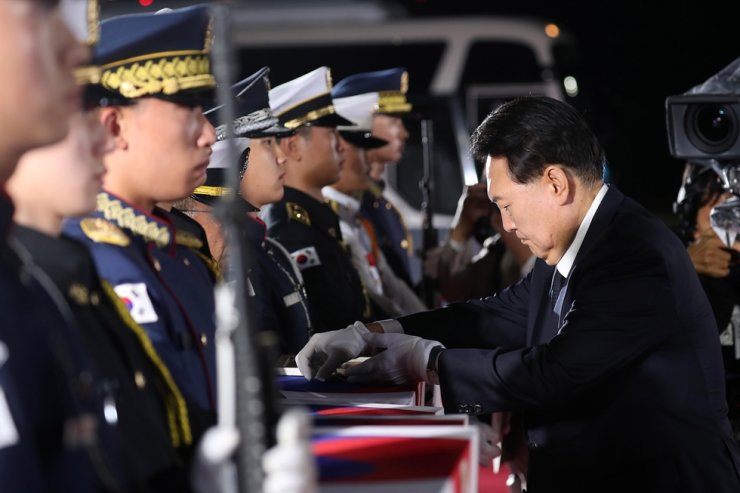Seventy years after the war between the two Koreas ended in a truce, South Korea and the United States have kicked off their first-ever joint underwater excavation mission to retrieve the remains of American troops killed in a Korean War crash.
Capable To Detect ‘New Types Of Aircraft’, Russian Military Receives ‘Newfangled’ A-50U AWACS
The South Korean Ministry of Defense (MoD) announced on September 22 that the joint excavation work in the waters off the southeast city of Busan, 320 kilometers southeast of Seoul, started on September 7 by 20 members of US Forces Korea and Defense POW/MIA Accounting Agency and ten troops of the South Korean military.
The project, which will go on until next week, is on course to find the remains of three American troops who were thought to be on board a B-26 bomber that went down into the sea in January 1953, soon after taking off from the K-9 air station in Busan, South Korean Yonhap News Agency reported.
Lee Keun-won, head of the Defense Ministry’s Agency for KIA Recovery and Identification, said, “Through the search operation conducted on the occasion of the 70th anniversary of the South Korean alliance, both countries were able to strengthen their cooperation to recover war remains.”
KIA is a widely known acronym for “killed in action.” After finishing their initial underwater operation next week, the two parties want to consider additional on-site searches to collect the remains. Seoul and Washington have worked together to find the remains of American soldiers killed during the battle after agreeing to conduct these digs in 2011.
The development comes after the remains of seven South Korean soldiers killed in the war returned home from the US in July this year. These troops were earlier believed to be the US war dead excavated from North and South Korea and sent to the United States. On a later examination, the remains were found to be those of South Korean troops that fought with US troops against the North Koreans.
The Korean War was fought between North Korea and South Korea from 1950 to 1953. The war began when North Korea invaded South Korea in June of 1950 following a period of insurrections in the south and a spate of border clashes.

While the United States and its allies supported South Korea, North Korea was supported by China and the Soviet Union. The armed hostilities finally ended in an armistice on July 27, 1953. This essentially means that the two Koreas are still technically at war.
The conflict resulted in up to 2 million casualties. Of these, at least 160,000 are believed to be South Korean soldiers. Seoul is, thus, on an uphill battle to recover the remains of its troops who laid down their lives in the war that still haunts the two Koreas.
The US has delivered the remains of 313 South Korean soldiers on seven different occasions since 2012. The identities of 19 sets have reportedly been established through DNA and other types of analysis. More than 7,500 Americans from the Korean War are still missing in action, which makes the latest mission very significant.
Interestingly, the excavation of soldiers who died in the war occurs when tensions are flaring in the region again as the US undertakes frequent military drills with the ROK military. North Korea fires one missile after another, to the former’s detriment.
The latest excavation mission is significant because it seeks to specifically look out for a crew that died in the crash of a bomber that saw extensive action in the first major conflict that the US participated in after WW2.
The B-26 Invader Bomber In Korean War
The Air Force’s light bomber during the Korean War was the World War II-era B-26 Invader. The aircrews of the Third Bomb Group (Light) and 452nd (later 17th) Bomb Group (Light) used their B-26s to attack the enemy’s supply lines and transportation network.
They conducted these “interdiction” missions during the daytime for the first year of the conflict. Still, later they were obliged to fly at night due to growing enemy anti-aircraft fire and the threat of the Soviet-origin MiG-15s operated by the enemies.
The B-26, originally designated as the A-26, was an attack aircraft employed during World War II for level bombing, ground strafing, and rocket strikes. When production halted after the war, 2,502 Invaders had been built. The A-26 was renamed the B-26 in 1948, which resulted in enduring misunderstandings with the Martin B-26 Marauder from World War II.
The aircraft made its third-ever appearance in the Korean War. B-26 Invader of the 3rd Bombardment Group was among the first American aircraft to take part in the Korean War, flying missions over South Korea on June 27 and 28 before the USAF launched its first attack on North Korea, bombing an airfield close to its capital Pyongyang.
They transferred to Pusan East (K-9) Air Base at the beginning of 1951 and continued their day and night intruder operations there. In June 1951, they joined the 3rd Bomb Wing (Kunsan (K-8)) for nighttime operations exclusively, splitting the target regions between the 452nd and the 3rd.
Although one of these bombers crashed shortly after taking off from the K-9 Air Base, the aircraft’s overall performance was widely lauded. They were awarded the Korean Presidential Citation and two-unit citations for their contributions during the Korean War. They were also given credits for eight highly successful campaigns.
- Contact the author at sakshi.tiwari9555 (at) gmail.com
- Follow EurAsian Times on Google News